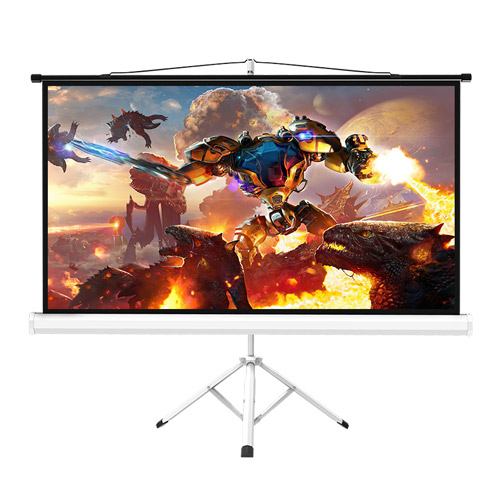Why Is the Tripod Screen Still the Smartest Choice for Portable Projection?
2025-10-27
The Tripod Screen has been a trusted projection tool for decades, yet its value continues to grow in modern display environments—from business meetings and educational lectures to home theaters and outdoor movie nights. A tripod screen consists of a projection surface mounted on a collapsible tripod stand, designed to offer portability, easy setup, and stable display performance.
Despite rapid advancements in digital display technology, the tripod screen remains relevant in 2025 because it provides versatility, cost-efficiency, and image quality that flat-panel displays cannot always match. Its design allows users to set up a large projection surface anywhere—in classrooms, offices, trade shows, or even temporary outdoor venues—without the need for wall mounting or permanent installation.
Why Choose a Tripod Screen Over Other Projection Options?
In a world filled with LED walls and fixed projection setups, the tripod screen distinguishes itself through mobility and simplicity. Businesses, educators, and event organizers continue to rely on tripod screens for several reasons:
-
Portability and Lightweight Design
Tripod screens are built to move. Their collapsible frames and retractable screens allow users to transport and install them in minutes, making them ideal for those who need mobility—such as trainers, exhibitors, or event coordinators. -
Flexible Size Options
They come in multiple aspect ratios and screen sizes, ranging from compact 60-inch models to expansive 150-inch versions. This adaptability makes them suitable for small meeting rooms as well as large conference halls. -
Durability and Stability
The three-legged design provides a secure and balanced structure even on uneven surfaces. Modern versions use anti-slip rubber feet and reinforced aluminum or steel frames, ensuring safety during use. -
Affordability and Longevity
Compared with motorized or ceiling-mounted screens, tripod screens are budget-friendly and require minimal maintenance, offering long-term value for both commercial and personal users. -
Multi-Environment Compatibility
Whether it’s an indoor presentation or an outdoor movie night, a tripod screen adapts easily. Its gain surface materials—typically matte white or high-contrast gray—deliver crisp and color-accurate visuals in different lighting conditions.
What Are the Key Specifications of a High-Quality Tripod Screen?
A professional tripod screen must balance portability, viewing performance, and structural integrity. Below is a summary of standard parameters used in top-rated models:
| Parameter | Specification Range | Description |
|---|---|---|
| Screen Size | 60” – 150” diagonal | Suitable for small classrooms to large auditoriums |
| Aspect Ratio | 4:3 / 16:9 / 16:10 | Compatible with projectors of different output ratios |
| Screen Material | Matte White / Glass Beaded / High Contrast Gray | Each type enhances brightness and color depending on use case |
| Gain | 1.0 – 1.3 | Ensures balanced brightness and color reproduction |
| Viewing Angle | 160° – 180° | Wide angle for clear viewing from multiple positions |
| Frame Material | Aluminum Alloy / Steel | Provides strength with lightweight portability |
| Tripod Height Adjustment | Up to 2.4 m (adjustable) | Enables versatile setup for different audience sizes |
| Black Backing | Optional | Prevents light penetration and enhances image contrast |
| Carrying Case | Included in premium models | Protects screen during transport |
These parameters help users identify the ideal model based on their environment and purpose. For example, a matte white 100-inch screen with 1.0 gain is suitable for educational and office use, while a gray high-contrast 120-inch screen enhances viewing in rooms with ambient light.
How Does a Tripod Screen Improve Visual Performance?
1. Enhanced Image Clarity
The high-quality reflective fabric ensures uniform light dispersion, minimizing hot spots and maximizing contrast. Viewers enjoy true-to-life visuals even when seated at side angles.
2. Effortless Setup and Adjustment
Tripod screens feature locking mechanisms that let users set their desired height quickly. The retractable rod allows for smooth screen extension and retraction, protecting the material from wrinkles or damage.
3. Versatility Across Applications
A tripod screen supports various projection technologies—DLP, LCD, and LED projectors—and can be used in corporate presentations, classroom lessons, gaming events, photography backdrops, and home theaters.
4. Easy Maintenance
Cleaning and maintenance require only a soft cloth and mild cleaning agent. The durable fabric resists mildew and yellowing, extending the product’s lifespan.
5. Environmentally Friendly Design
Many new-generation tripod screens are manufactured using eco-friendly PVC or PET materials, ensuring minimal environmental impact and compliance with modern sustainability standards.
Common Questions About Tripod Screens
Q1: How do you choose the right screen size for your projector?
A1: The ideal screen size depends on the throw distance of your projector and the room dimensions. As a general rule, the screen height should be one-sixth of the distance between the screen and the last row of the audience. For example, if the room is 6 meters deep, a screen around 100 inches diagonal provides comfortable visibility. Always check your projector’s native resolution and aspect ratio to match the screen format.
Q2: Can a tripod screen be used outdoors?
A2: Yes, tripod screens are excellent for outdoor movie nights or presentations, provided they are used on stable ground and under mild weather conditions. To prevent instability, users should secure the legs with small weights or stakes in windy conditions. Choosing a screen with a black backing also enhances contrast when used outdoors.
What Is the Future Trend of Tripod Screens and Beyond?
As hybrid workplaces, e-learning platforms, and mobile events continue to expand, the demand for portable projection solutions is rising globally. Modern tripod screens are evolving beyond their traditional role through:
-
Integration with Smart Projectors
New models are being designed to pair seamlessly with wireless mini projectors, offering fast, cable-free setup and improved visual performance. -
Advanced Screen Materials
The next generation of tripod screens employs nano-coated fabrics that enhance reflectivity, color accuracy, and wrinkle resistance while maintaining portability. -
Compact, Foldable Designs
Manufacturers are focusing on ultra-slim frames and fast assembly systems, catering to professionals who require quick deployment during travel or roadshows. -
Sustainability and Recyclable Components
With growing environmental awareness, more companies are shifting toward eco-friendly, fully recyclable materials without compromising image quality. -
Customization Options
Tripod screens can now be tailored for specific use cases—such as high-gain coatings for bright environments, or 3D-ready surfaces for immersive experiences.
The global market for projection screens is projected to grow steadily, supported by education, entertainment, and corporate sectors. Portable solutions like tripod screens remain essential due to their unmatched convenience and adaptability.
Conclusion: Why Tripod Screens Will Continue to Lead the Portable Display Market
Even in the era of interactive panels and digital displays, tripod screens maintain a vital place in visual communication. Their simplicity, affordability, and consistent performance make them the go-to choice for a wide range of users—from educators and business presenters to entertainment enthusiasts.
For professionals seeking high-quality, durable, and easy-to-use projection screens, Huinuo stands as a trusted name. With years of expertise in screen manufacturing, Huinuo offers advanced tripod screens engineered for superior brightness, long-term stability, and user-friendly operation.
Whether it’s a corporate presentation, an educational seminar, or an outdoor film night, Huinuo’s tripod screens deliver crisp visuals and professional results every time.
For more details, specifications, or custom requirements, please contact us directly — our team will assist you in finding the perfect screen solution for your needs.



